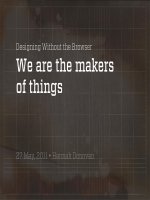the genomics age how dna technology is transforming the way we live and who we are - gina smith
Bạn đang xem bản rút gọn của tài liệu. Xem và tải ngay bản đầy đủ của tài liệu tại đây (2.43 MB, 273 trang )
THE GENOMICS AGE
This page intentionally left blank
THE GENOMICS AGE
How DNA Technology Is Transforming
the Way We Live and Who We Are
GINA SMITH
AMERICAN MANAGEMENT ASSOCIATION
NEW YORK
✸
ATLANTA
✸
BRUSSELS
✸
CHICAGO
✸
MEXICO CITY
SAN FRANCISCO
✸
SHANGHAI
✸
TOKYO
✸
TORONTO
✸
WASHINGTON, D.C.
This publication is designed to provide accurate and authoritative information in regard
to the subject matter covered. It is sold with the understanding that the publisher is not
engaged in rendering legal, accounting, or other professional service. If legal advice or
other expert assistance is required, the services of a competent professional person
should be sought.
Library of Congress Cataloging-in-Publication Data
Smith, Gina.
The genomics age : how DNA technology is transforming the way we live and who we are
/ Gina Smith.
p. cm.
Includes index.
ISBN 0-8144-0843-5
1. Genetics—Popular works. 2. Genomics—Popular works. 3. Genetics—Social aspects.
4. Genomics—Social aspects. I. Title.
QH437.S654 2005
2004012595
© 2005 Gina Smith.
All rights reserved.
Printed in the United States of America.
This publication may not be reproduced, stored in a retrieval system, or transmitted in
whole or in part, in any form or by any means, electronic, mechanical, photocopying,
recording, or otherwise, without the prior written permission of AMACOM, a division of
American Management Association, 1601 Broadway, New York, NY 10019.
Printing number
10 9 8 7 6 5 4 3 2 1
Special discounts on bulk quantities of AMACOM books are available to corporations,
professional associations, and other organizations. For details, contact Special Sales
Department, AMACOM, a division of American Management Association, 1601
Broadway, New York, NY 10019.
Tel.: 212-903-8316. Fax: 212-903-8083.
Web site: www.amacombooks.org
CONTENTS
Before We Begin . . . 1
An introduction
1 It’s Who You Are 9
You need to understand some basic terms and ideas to make sense of
the DNA sciences. Don’t know a gene from a chromosome? This is the
place to start.
2 How We Got Here 27
Fifty years after Watson and Crick discovered the DNA double helix, the
Human Genome Project announced the final version of the human
genome. How did we get here from there? Here’s an inside look at how
one of the biggest discoveries in the history of mankind came about.
3 Your Genome—An Owner’s Manual 55
You are of the first generation in the history of the human race to
understand what makes you . . . well, you. The fascinating discoveries
scientists have made about DNA could change your life, your health,
and society.
4 The DNA Files 69
The most important advance to come out of his work, says DNA dou-
ble helix discoverer James Watson, is the exoneration of death row
inmates. DNA fingerprinting has revolutionized crime solving, and is
helping historians solve centuries-old mysteries.
5Facing Destiny 87
It would’ve seemed like science fiction just a few decades ago, but
today genetic testing can predict susceptibility for hundreds of disor-
ders. Who are the innovators? What tests are out there? Will govern-
ment permit insurance companies and employers to discriminate
using the new knowledge? Genetic testing, in plain English.
6 The Fountain of Aging Well 113
It is one of DNA science’s most exciting fields. Biogerontology. A San
Francisco scientist has increased a worm’s lifespan sixfold! Two
gerontologists are betting a half-billion dollars that in 2150, at least
one person alive today will still be alive! Meanwhile, companies vie to
create a pill that will help tomorrow’s baby-boomer senior citizens
seem decades younger than their years.
7 Closing in on Cancer 133
In the 1970s, Nixon declared war on cancer. This was back when doc-
tors thought it was a single disease. By the mid-1990s, most scientists
had lost hope, and cancer deaths were at an all-time high. Now, for the
first time, the majority of cancer specialists have renewed faith that,
thanks to the DNA sciences, most cancers will be cured
—
in the next
twenty years. Here are the players and the technologies.
8 Cloning and Stem Cells 157
It doesn’t get more controversial than this. Despite calls for a global ban
on cloning
—
both the kind that produces “mini me” humans and the kind
that yields potentially life-saving stem cells
—
the world’s scientific com-
munity is pushing hard to keep stem cell work alive, saying it’s our best
hope of curing most of the degenerative diseases that kill people today.
Here is an inside look at the players, and the arguments from both sides.
9 Gene Therapy 173
Gene therapy
—
or actually modifying defective genes in patients to
cure them
—
was once the holy grail of DNA medicine. Then came set-
backs
—
a teenager dies in a gene therapy trial and several French chil-
dren get leukemia
—
and everything changed. Now gene therapy
experts are trying to fight their way back to the forefront with a long
list of therapies and cutting-edge trials in labs around the country.
VI
~
CONTENTS
10 DNA and Society 193
When most people hear the word eugenics, they think of the Nazis’
attempt in the 1930s and 1940s to murder their way to an Aryan
Germany. But few people know that eugenics
—
the pseudoscience of
genetically breeding humans
—
was first popularized decades earlier in
America. Eugenics was the first societal effort to manipulate genet-
ics. Should we fear that a new eugenics is in the offing? What are the
ethical issues as the DNA sciences barrel into the future?
Notes 211
Glossary 225
Every word you’ll ever need to know to keep up with DNA researchers
and companies in the news, for investing and making societal and per-
sonal choices.
Index 255
CONTENTS
~
VII
This page intentionally left blank
THE GENOMICS AGE
This page intentionally left blank
IT IS A GREATER
achievement than the discovery of vaccines
and antibiotics combined. And it is no exaggeration to say that, as a
result of it, the world of human beings will never be the same.
I am talking, of course, about the discovery of the DNA double
helix by an American and a Brit, James Watson and Francis Crick,
in 1953. On a chilly February day, something profound happened.
It barely got a mention in the papers that whole year. But Watson
and Crick, they knew. “We found it!” Crick shouted upon bursting
into The Eagle, an off-campus pub close to their University of
Cambridge lab. “We have found the secret of life!”
1
In April 2003, fully fifty years later, history was made again. A
group of scientists announced they had taken Watson and Crick’s
great insight to yet another level. They published an enormous
list—a list of the chemicals that make up all the genes in the DNA
BEFORE WE BEGIN. . .
INTRODUCTION
of the human race. In other words, they published the sequence of
the human genome. And now the life-changing work can begin.
Knowing what a human being is made of is the first step toward
knowing how to fix that human being when something goes wrong,
or how to prevent something from going wrong in the first place.
Eventually, it might even mean knowing how to build a better
human being altogether. All of this is important, critical, even. But
something also happened when this knowledge came to light. We
humans—who are so happy with ourselves and our ability to rea-
son, to investigate, to manipulate nature—became the first beings
on the planet to take a look at ourselves at the most primary level,
discovering the language in which our very existence is written.
The sum total of genes in a species—the DNA information that
determines whether you have hair or hooves, teeth or a tail—is
called the genome. Genomics is the emerging science of under-
standing the human genome, and of determining how the DNA in
every human being affects identity, health, and disease. And
genomics is launching other sciences almost as quickly as you can
learn the terms. First functional genomics, then comparative
genomics, then proteomics . . . the science breaks into subsets and
into subsets again.
But one thing is certain. No matter how you slice and dice it, the
new science of DNA will transform everything it touches: Medical
treatment and diagnosis, especially. Criminology and genetic pro-
filing. Cancer research and anti-aging. History. Ethics. Politics. And
don’t forget about the economy. Universities and businesses are
sinking tens of billions of dollars into DNA-related fields.
“It’s a giant resource that will change mankind, like the printing
press,” says James Watson, who should know.
2
Johannes Gutenberg invented the movable-type printing press
around 1450, and by the year 1500, there were a thousand books in
Europe. That pace of change is generally considered to be extraor-
dinary, but this DNA revolution puts that progress to shame.
2
~
THE GENOMICS AGE
In 1985, when I was an undergraduate studying chemistry at
Florida State University, my organic chemistry professor told the
class that the human genome wouldn’t be mapped in our lifetimes.
For a while, it looked like he was right. After all, the first genome—
of the simple bacterium that causes meningitis—wasn’t even
decoded until 1995. It was tiny, and even that took years to do.
Then science turned a corner. Thanks mainly to advances in
computer technology, researchers were able to outline the first draft
of all three billion components of human DNA, about 200 New
York City phone books worth of As, Cs, Ts, and Gs.
There still is an enormous amount of work to be done.
Researchers are now trying to understand the contents of the book
they have opened. According to Francis Collins, Human Genome
Project leader, it is as if we have discovered the Book of Life, only
to find the book is written in an unknown language. That means
there is much left to do, and the benefits of the DNA sciences will
arrive piecemeal, as we become increasingly fluent in its grammar
and peculiar turns of speech.
And we must be careful not to get carried away with the hype
surrounding this high-profile work. The tendency, says Collins, is
to hear about the discovery of a new gene—such as a gene related
to diabetes or heart disease—and immediately expect a cure for
the ailment.
“Predictions in science tend to be over-optimistic in the short
run,” Collins told me as I was finishing up the first draft of this
book. “But they tend to be under-optimistic in the long run. I think
that applies here, too. Wildly overstated expectations of immediate
benefits and [disease cures] from the Human Genome Project
helped fuel the biotech frenzy of the late 1990s, but no one I knew
thought that these expectations had any chance of happening at
such a rapid pace.
“When the investment bubble burst,” he added, “some people
began to complain that the Human Genome Project was a failure
BEFORE WE BEGIN
~
3
and hadn’t paid off. But it was the outrageous predictions that failed
and didn’t pay off. We will get there. It will happen. But not tomor-
row or the next day. After all, it’s one thing to derive the three bil-
lion letters of the code accurately and publicly. We’ve done that. But
it will now require the best and brightest brains on the planet to go
to the next level of understanding.”
3
But anyone wanting to put their excitement on hold because of
that long to-do list need only look at extremely important genomics
work that has already arrived. These results would’ve seemed like
science fiction just a few years ago.
Consider. DNA evidence testing has proved the innocence of
144 convicted inmates—and counting—as of this writing.
4
It’s
cleared so many people on death row that, in 2003, then-governor
George Ryan of Illinois commuted all the state’s death sentences to
prison terms of life or less.
Even historical crime mysteries are finding solutions. For
instance, DNA evidence seems to have posthumously vindicated
Sam Sheppard, who was accused of killing his wife in 1954. (You
may remember the Sheppard case as the inspiration for the TV
show and movie, The Fugitive.) The long-standing rumor that
Thomas Jefferson fathered children with his slave, Sally Hemings,
is now confirmed. Genetic tests show that some of the Hemings
children were directly related to a Jefferson male.
And DNA evidence is being used to figure out everything from
where Christopher Columbus is buried to whether Billy the Kid
actually died in the1880s or, as rumored, lived on to be known as
Brushy Bill, the elderly nursing home resident who, in the 1950s,
claimed to be him.
The field of genetic testing is currently exploding, too. As
researchers peg more and more gene mutations to specific disor-
ders, DNA tests allowing you to be tested for them are right
behind. You and your unborn child can already be tested for sus-
ceptibility for hundreds of diseases. In some case, finding out
4
~
THE GENOMICS AGE
about a potential disorder and taking measures now to avoid it can
save your life.
DNA medications are starting off more slowly, but they’re com-
ing, too. The startling effectiveness of DNA medicines such as
Enbrel for rheumatoid arthritis and Gleevec for a certain kind of
leukemia paints an optimistic future for medicines that precisely tar-
get the genetic problem behind a disease. And scientists believe they
are on the threshold of creating personalized medicines—chemicals
specially designed to work best with your particular genetic makeup.
The holy grail of the DNA sciences—the immediate tracing of
every human disease and disorder to a single gene or group of
genes—is further off. Yes, there has been progress in finding the
genes linked to diseases such as cancer, heart disease, and diabetes.
You’ll read about a lot of that progress in this book. But it is cer-
tain to be more difficult than people once suspected. Most disor-
ders aren’t just mutations of a single gene, but many. And to treat
genetic diseases, it will be necessary not only to understand the
gene involved, but also the proteins the gene makes and everything
that happens along the pathway from mutation to disorder. This
will be the hard part.
Yet whether it takes years or decades, this much is certain:
Medicine is forever changed. Because scientists now understand
something about DNA, they are already using DNA knowledge to
manufacture human hormones, help reduce heart blockages, shrink
tumors, and treat multiple sclerosis. More developments are com-
ing and, if history is any guide, they will greet us at a faster and
faster rate.
Eventually, we will be living in a world where diseases are not
just treated; they will be prevented from occurring in the first place.
Nobel Laureate David Baltimore told me that he had chills when
he first read the paper that detailed the human genome. And he’s
seen a lot of biology in his long career. He is now the president of
the California Institute of Technology.
BEFORE WE BEGIN
~
5
Biology, he says, has entered a new era. “Instead of guessing
about how we differ one from another, we will understand and be
able to tailor our life experiences to our inheritance. We will also
be able, to some extent, to control that inheritance. We are creat-
ing a world in which it will be imperative for each individual per-
son to have sufficient scientific literacy to understand the new riches
of knowledge, so that we can apply them wisely.”
5
Scientists such as Baltimore have long understood the frontier
of the human genome and what it means to human beings. For the
rest of us, it’s taken a little longer. For most Americans, the science
and terminology of the DNA revolution are brand new, just now
appearing in the papers and on TV.
The science of DNA is simple, elegant, and ultimately graspable.
You just need a little background in it, a little insight into who’s
doing what, what’s coming, and what’s just plain hype.
Cutting to the quick of the so-called DNA revolution is what this
book is all about.
✸ ✸ ✸
My goal with this book is to stick to developments likely to
unfold in the next several years, detailing the advances that DNA
research is expected to bring. That way, you can profit from the
knowledge in your lifetime.
In the first three chapters, I’ll get you familiar with the terms,
techniques, and background you need to understand the rising tide
of DNA stories in the news. If you don’t know a gene from a chro-
mosome—or if you just need a refresher on some newer terms and
techniques—this section is for you.
Then, we’ll take a look inside the labs, where key developments
are happening in the hot areas of DNA fingerprinting, gene test-
ing, cancer research, gene therapy, cloning and stem cell research,
and anti-aging experimentation. In Chapters 4 through 9, you’ll
6
~
THE GENOMICS AGE
meet the minds behind the science, plus gain a plain English under-
standing of how they’re taking on the challenge.
Finally, we’ll reflect. Though I’ve included comments from ethi-
cists and social scientists throughout, Chapter 10 digs deeper into
the ethical issues facing us all. Should governments be permitted to
compile DNA databases of each and every one of us? Could genetic
testing result in an uninsurable and unemployable underclass? How
will the DNA revolution affect your life and that of your family? I’ll
examine how current developments and their rush to reality will
change the world for our children and our children’s children.
These are issues we all need to think about. But without a decent
grounding in the science of DNA—who the players are and what
the technology is all about—the right decisions are difficult to
make. You can’t invest in or follow the DNA industry without know-
ing this stuff, either.
It’s my hope that this book will give you not only the insight into
what’s happening in this historic revolution, but also the lay lan-
guage and background to ask the hard questions—of yourself, the
politicians who represent you, the business world, and the scientific
community. There aren’t too many other books that take on this
challenge, but you’ve found one.
Now, onward!
BEFORE WE BEGIN
~
7
This page intentionally left blank
RIGHT AROUND
the time Washington crossed the Delaware
River, the French chemist Antoine-Laurent Lavoisier wrote this in
his notebook: “La vie est une fonction chimique.”
Life is a chemical process.
Lavoisier was either lucky or prescient. (If he was lucky, it didn’t
last. French revolutionaries jailed and beheaded him in 1794.) But
it was two centuries before scientists figured out the basic principles
of heredity and came to widely accept that we inherit traits from our
parents through a process that can only be called “chemical.”
Heredity is carried in our genes—genes that are made of DNA.
In the year 2000, scientists announced that they had launched
what they said was a scientific revolution, that they had opened the
book on human life. Three years later, in April 2003, they delivered
the final version of that book.
IT’S WHO YOU ARE
CHAPTER ONE
They claimed they had figured out—chemical by chemical—
what the DNA in human genes is made of.
“Essentially, we are now able to read our own instruction books,”
explains Francis Collins, director of the National Human Genome
Research Institute in Bethesda, Maryland. And the term “instruc-
tion book,” he says, hardly begins to define what the effort has
uncovered. It is also a history book explaining how humans have
evolved over time. It’s a shop manual that describes with incredible
precision how to build every cell in the human body. And most
important, Collins says, it’s a medical textbook containing insights
that will help doctors predict and, eventually, cure disease.
It is humbling for me and awe inspiring to realize that we
have caught the first glimpse of our own instruction book,
previously known only to God.
Dr. Francis Collins, Human Genome Project leader*
“We are the first generation in history to turn the pages of this
book, an awesome and humbling experience for anyone to con-
template. In considering epic moments in human history, this has
to be very high on the list. History will decide,” he adds, “but I
would place the Human Genome Project alongside splitting the
atom or going to the moon.”
1
Introducing Your DNA
As most everyone knows by now, DNA is short for deoxyribonu-
cleic acid. But do you know where your DNA is? Can you tell a
gene from a chromosome? Did you know that your genes are
located on your chromosomes and not the other way around? Do
10
~
THE GENOMICS AGE
* Collins’s remarks, and others highlighted in this chapter, are taken from “What
They Said: The Genome in Quotes,” BBC News (June 26, 2000). This com-
pendium of quotes from the public announcement of the completion of the rough
draft of the human genome sequence is available at />hi/sci/tech/807126.stm.
you know how cloning might be used to fight diabetes, which com-
panies are using worm DNA to figure out how to slow human aging,
or how doctors are employing DNA knowledge to finally win the
fight against cancer?
Most people don’t.
The DNA sciences will dominate in the twenty-first century, and
you need to understand the terms and the concepts if you’re going
to stay on top of and benefit from the huge DNA-related advances
in medicine and other sciences.
At first, the science seems intimidating, but once you get a grasp
of a few terms and concepts, you’ll see it is all actually quite simple.
A View from the Top
You hear a lot about DNA “carrying” information—and I’ll get to
that in a minute. But first, let’s talk about DNA as an object, an
actual molecule that takes up physical space.
To give you some perspective, let’s start big and get smaller.
Take a human body, any body. It consists, you may know, of ten
systems: nervous, muscular, skeletal, endocrine, digestive, respira-
tory, circulatory, immune, reproductive, excretory.
I think we will view this period as a very historic time, a new
starting point.
Craig Venter, founder of Celera Genomics
Each of those systems has organs. For instance, the stomach is
an organ of the digestive system.
Every organ—like every living thing—is made up of cells. The
stomach is made of stomach cells.
Almost every cell, stomach or otherwise, has a nucleus at its cen-
ter. And this is, for me, where things get interesting.
Every nucleus includes chromosomes, rod-like structures that,
under a microscope, most resemble bundles of thread. Every cell’s
IT’S WHO YOU ARE
~
11
nucleus contains exactly twenty-three pairs of these chromosomes.
(The exception to this is reproductive cells, which contain half the
normal amount of chromosomes. That makes sense considering
that reproduction is the result of the fusing of two cells—a sperm
and an egg.)
Look closer at any particular chromosome—let’s choose chro-
mosome 19 inside the particular nucleus of a stomach cell we’re
examining—and you’ll find that chromosome’s DNA tightly coiled
up inside. If you unraveled that DNA and straightened it, you would
find that it is shaped very much like a ladder. Sugars and phosphates
form the sides of each ladder, and the four so-called “bases” pair up
to form the rungs.
This is the outstanding achievement not only of our life-
time, but in terms of human history. I say this because the
Human Genome Project does have the potential to impact
the life of every person on this planet.
Dr. Michael Dexter, director of The Wellcome Trust
The bases are guanine, adenosine, thymine, and cytosine—G, A,
T, and C for short. You may also hear them called letters or
nucleotides. If you think of DNA as a language, and I do, then this is
the alphabet.
A given gene (made of DNA) is simply a given group of base
pairs on a DNA molecule. For instance, here on chromosome 19
you can find a long string of bases that together form the so-called
APOE gene. If you were unlucky, you may have inherited a danger-
ous variety of this gene (there are three varieties) on your chromo-
some 19. This could affect your ability to break down cholesterol
and fat—leading to coronary heart disease, Alzheimer’s, or other
fat-related ailments.
However, and this is where the gene sequence could come in
handy, if you were able to discover this risk factor early, through a
12
~
THE GENOMICS AGE
genetic test, you might choose to go easy on the bacon double
cheeseburgers, a choice that could extend your life.
WHY YOU AREN’T A BLUE BLOOD
For centuries, presumably all the way back to Aristotle, folk-
lore had it that heredity passed through our blood. Think
of the terms “bad blood,” “mixed blood,” “royal blood,”
“blue blood,” or “bloodline” and you get the idea.
The irony is that there is no heredity coded in your red
blood whatsoever. The red blood cells are the only kind of
cells in your body that don’t have DNA—because they’re
the only cells in your body that don’t have nuclei.
Go figure.
To summarize, you have about 30,000 genes located throughout
your twenty-three pairs of chromosomes, which are found in the
nucleus of almost every one of your cells. These genes describe, in
the alphabet of Gs, As, Ts, and Cs, everything about you—from
how tall you are, to how curly your hair is, to how likely you are to
suffer from bad breath or cancer.
Your personal DNA sequence is the language in which every-
thing about you is written. Interestingly, almost every cell in your
body has all the information required to build an entirely new you.
Visualizing Your DNA
A single DNA molecule is incredibly long and skinny. Uncoiled
from a microscopic chromosome, a single strand would stretch
about two inches. String out all the DNA from all twenty-three
chromosomes from a human egg just about as big as the comma at
the end of this clause, and its length would add up to about six feet.
Line up all the threads of DNA from every cell in your body end
to end, and the entire length would be long enough to reach to the
IT’S WHO YOU ARE
~
13
~~~~~~~~~~~~~~~~~~~
sun and back 500 times. But the same strand would be many thou-
sands of times skinnier than a human hair.
In the deepest sense, DNA’s structure and function have
become as much a part of our cultural heritage as
Shakespeare, the sweep of history, or any of the things we
expect an educated person to know.
Microbiologist Ross L. Coppel, from his book with G.J.V. Nossal,
Reshaping Life: Key Issues in Genetic Engineering (Melbourne, Aus-
tralia: Melbourne University Publishing, 2002)
Now consider how compact your DNA is. Almost every cell in
your body contains more than six feet worth of DNA coiled up inside.
Even so, the standout feature of DNA is the way it stores infor-
mation—information that precisely instructs the cell how to repli-
cate itself and what functions to perform.
But What Does DNA Do, Exactly?
DNA’s job is simple. Its code tells your body how to build protein.
Protein is at the foundation of all living things. All living cells
depend upon proteins for virtually all their products and processes.
Cells—whether they’re bacteria, plant, or animal cells—use pro-
teins for a variety of processes, from fighting infection, to sending
and receiving messages, to rebuilding damaged parts.
You, as a human being, contain at least 50,000 different kinds of
protein. And each kind of protein has a specific job to do. There are
structural proteins for building your hair (collagen), your skin (ker-
atin), and your ligaments (elastin). Hormonal proteins like insulin
carry messages and regulate body processes. The hemoglobin in
your blood is one example of a transport protein. There are anti-
body proteins to protect your cells against invaders and protein
enzymes for digesting and otherwise breaking things down. The list
goes on and on.
14
~
THE GENOMICS AGE









